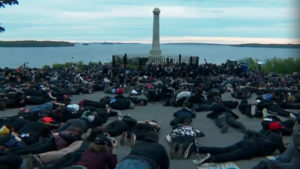Navajo code talkers used their language to devise a code that helped America win WWII.
Many Native American children were punished for speaking their native tongues.
The code talkers’ legacy is an important part of Native American and American history.
In May 1942, 29 Navajo men arrived at Camp Elliott, the original Marine Corps training base during World War II. Stretching 32,000 acres in San Diego, the base contained encampments, bivouac areas, and 41 firing ranges.
But the small unit of Navajo men weren’t there to learn how to fight, at least not with guns. They had instead been tasked with creating an unbreakable code to help defeat enemy forces.
In the early months of the war, Japanese intelligence experts had easily broken every code devised by the US military. A man named Philip Johnston proposed the idea of recruiting Native Americans to develop a code that would be indecipherable to enemies. The son of a Protestant missionary, Johnston had grown up on the Navajo reservation, and realized the language was almost impossible to master without early exposure.
The program proved a success, and expanded to include around 400 Native American code talkers in WWII.
The irony of using their language to help a country that had sought to eradicate Native American culture through systemic policies was not lost on the Navajo code talkers. But this was their country, too, and they were ready to defend it.
“We used our language to defeat the enemy,” Chester Nez, one of the original 29 code talkers, recalled in an oral history project decades later.
Some Navajo children were punished for speaking their native language
The US military picked the Navajo as its main source of code talkers since they were “the only tribe in the United States that has not been infested with German students during the past 20 years,” commanding general Clayton Vogel wrote in a March 6, 1942 letter.
After the US successfully used the Choctaw language to transmit secret messages during World War I, Germany and Japan had sent students to the US to study Native American languages. Navajo was one language they did not pick up.
The US military sent officers to Navajo reservations and government boarding schools to recruit willing boys and men. Most of the approximately 400 Native American code talkers were 15 to 35 years old — many “just boys with little exposure to the world outside the Navajo reservation,” according to Paul Gosar, House Representative from Arizona, in a 2011 speech to Congress.
Nez was in the tenth grade when a Marine recruiter came to the boarding school he attended seeking young Native Americans who were fluent in Navajo and English. He jumped at the chance to defend his country, he said in his oral history. Leaving the boarding school — where he had had his mouth washed out with soap for speaking Navajo — was a plus.
Nez lied about his age, and even kept the decision to enlist a secret from his family, according to the AP. Soon after, he landed at Camp Elliott along with 28 other Navajo men, ready to help their country win the war.
Devising unbreakable codes
The code talkers had to develop and memorize unique military codes, which could not be written down and existed only among the small group. Under high-pressure battle conditions, the code talkers had to quickly and accurately recall their code and transmit the missives via radio — or risk hundreds or thousands of lives.
The Type 1 code consisted of 26 Navajo words that stood for individual English letters. For example, the Navajo word for “ant,” “wo-la-chee,” was used to represent the letter “a” in English.
To speed up transmissions, the code talkers then developed the Type 2 code, which included a dictionary of 411 terms for military words that didn’t exist in the Navajo language. A submarine became “besh-lo,” or “iron fish” in Navajo, and “fighter planes” were “dah-he-tih-hi,” which means “hummingbirds.” To say “America,” the code talkers used “ne-he-mah,” or “our mother.”
The code was an astonishing success, remaining “the only unbroken code in modern military history,” according to Gosar.
The work of hundreds of code talkers were essential to securing Allied victory in the war, especially in the Pacific.
“Were it not for the Navajos, the Marines would never have taken Iwo Jima,” Major Howard Connor said.
The Navajo code talkers were kept secret for years after the war
The sensitive nature of military codes meant code talkers had to keep their work secret, even from family members. The code talker program was declassified in 1968, but it wasn’t until more than a decade later that they were recognized as national heroes.
On July 28, 1982, President Ronald Reagan designated August 14 as Navajo Code Talkers Day, recognizing the veterans as national heroes. And, in 2001 — nearly 60 years after they created their legendary code — Native American code talkers were awarded Congressional Gold Medals.
But the country’s appreciation of Navajo culture and language will once again be put to the test. This fall, the Supreme Court is considering a case that could gut Native American sovereignty and erode efforts to preserve tribal culture.
Though the verdict may be months to come, the legacy of the code talkers will remain in American history.
“It’s one of the greatest parts of history that we used our own native language during World War II,” Nez told the AP. “We’re very proud of it.”




